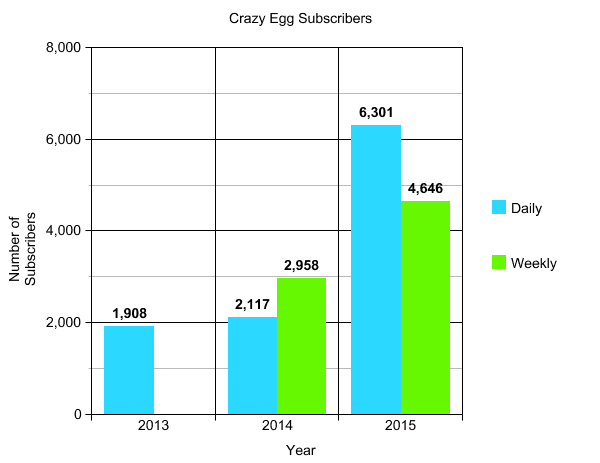I just had my 2-year anniversary as Managing Editor of the Crazy Egg blog. In celebration, I recently took my annual “deep dive” into the numbers.
This year, the number I’m most pleased with is the subscription rate.
In 2013, we had 1908 subscribers. In 2014, that number rose to 5,075. Today, we have 10,947.
That’s 473.74% growth—more than doubling the blog subscription rate two years running.
So what are the tactics that create this level of growth? Here’s what’s working for us.
Give your subscribers a choice
You’ve read that people are paralyzed by choice, that you should limit choices. But there’s another side to this issue. When the options aren’t life-changing or overly complicated, choice empowers people.
It may be a small thing, but allowing people to choose the number of emails they get from you helps them feel as if they’re in control, which makes them like you all the more.
One of the first things I did when I took over the blog was to create a second subscription level. Okay, to be honest, I did it backwards. I turned our daily newsletter into a weekly one and then created a new daily list, which people had to consciously opt into.
But it worked.
One year later, that weekly list (the original list) had grown from 1908 to 2958—essentially doubling in size—and the new daily list had grown from 0 to 2117 subscribers. All told, we nearly tripled subscriptions simply by giving readers a choice.
The thing to note is that every one of the people on our daily list chose it, so there are no irritated subscribers complaining about too many emails.
Yes, we still get unsubscribes because someone doesn’t have time to read everything, but now we offer an alternative. Our fans can still be engaged without getting more emails than they can manage.
Be clear about what subscribers can expect
Another change that made a huge difference was to create a “Subscribe” page—for all practical purposes, a sales page for the newsletter.
Overkill, perhaps. But when I took over the blog, we had a lot of unhappy subscribers. I don’t understand why—if you subscribe, you should expect to receive emails—but that’s people.
After creating a long-form page that clearly explains what you get when you subscribe, the complaints stopped. And that makes me happy.
Even better, it’s nothing fancy. Take a look at the forms I embedded on that page.
Quality matters
No one subscribes to a low-quality blog. That’s why one of my highest priorities has been to raise the quality of both the writing and the content on the blog.
I’m pretty strict:
- You must write intelligently and engagingly (and like a native English speaker).
- You must have something unique to say (no rehashing what’s already all over the Web).
- If you make a claim, back it up with statistics or a real-life example.
- Your presentation must be logical and easy to follow.
- The information must be useful and actionable.
Not every article makes the cut. And the ones that do often require extra work from me. But that effort pays off. I’ve been able to build a team of fantastic writers, and we attract some impressive guest writers.
As you might guess, my goal is to work with writers who need little or no editing. Sometimes, though, great content comes from professionals who know the topic but aren’t trained writers.
As editor, I try to take that content from good to great, so readers get the full benefit of insider tips—in clear, readable prose.
By the way, this focus on quality never ends. This year, I’m trying to take the graphics up a notch too.
Be real; be human
People follow people, not brands. So you need to make sure the people behind your blog are engaged. I ask my writers to help us share their posts and respond to comments. It makes a difference.
When readers realize their blog subscription keeps them in touch with their favorite writers (as well as updated on what’s working in conversion optimization), it only makes sense to subscribe.
Make it easy to subscribe
Last year, I tested a popup subscription box. I didn’t love it, and it didn’t impact our subscription rates that much. This year I took it down, but don’t think for a minute I don’t give people opportunities to subscribe:
- In the header is a subscription form.
- I created a large graphic in the sidebar that offers an ebook for daily subscribers.
- Below each article is another subscription form.
- And as I mentioned above, I created a “Subscribe” page and put the link with other important pages in the sidebar.
If someone wants to subscribe, I make it as easy as possible—without making a pest of myself.
There’s a fine balance, and you’ll need to test different options to know what works best for your blog.
Make it worth their while
This goes deeper than quality content and engagement. When I created the second newsletter option, I spent a lot of time trying to figure out what I could offer that would make the daily list “special.”
Is that necessary? No. A daily versus weekly email is simply a matter of preference, but I still want to reward anyone who chooses the daily email.
In the end, I opted for simplicity: an ebook for subscribing and special partner offers at the bottom of each email.
Bottom line, your subscription list is valuable. Take time to consider ways to keep your fans active and engaged. It can make a huge difference in your subscription rates.
It doesn’t take much
To get more subscribers, you need to create a blog that people want to read. Start by stepping back and reviewing your blog from your readers’ perspective.
- Are you offering unique, useful information?
- After reading your articles, do people feel they invested their time well… or was it a waste of ## minutes?
- Do you make it easy for readers to decide if an article offers information they need? (Learn about the nut graf here.)
- Do your articles look inviting and readable?
Quality must be your primary focus: the highest quality writing, the highest quality information, the highest-quality presentation.
Then, to drive subscriptions:
- Give readers plenty of opportunities to subscribe.
- Allow them to control how many emails they get from you.
- Reward your most engaged subscribers.
The good news? It’s not rocket science. What’s working on Crazy Egg will work for any brand.
Get to know your audience. Test different tactics. And tweak to keep your subscription rates rising. That’s it.
You can run special campaigns and use other advanced tactics. But simply using proven growth tactics, I doubled Crazy Egg’s subscription levels two years running.
What’s working for you?




